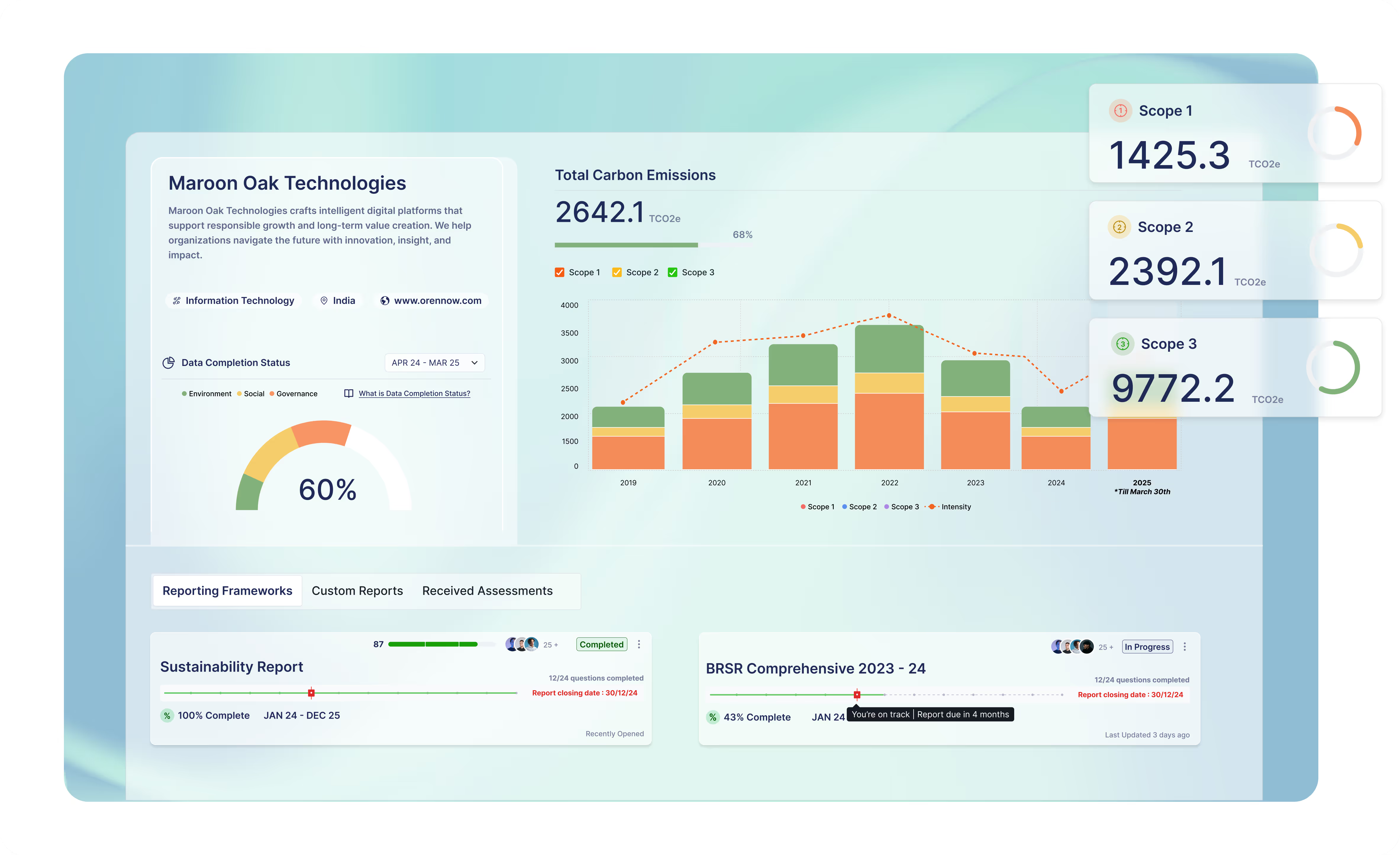Scope 1, 2 & 3 Emissions Linking Data To Real World Action

Companies are a major cause of climate change, causing impact by releasing Greenhouse Gases (GHGs) through their daily operations, energy use, and supply chains. Understanding and controlling these emissions requires a clear framework that deals with them.
Scope 1, 2, and 3 emissions help companies analyse and categorise their environmental impact based on how they contribute to the emissions. This classification enables organisations to identify emission sources, measure their carbon footprint accurately, and improve carbon emissions reporting for greater transparency.
What are Scope 1, 2, and 3 emissions?
Scope 1, 2, and 3 emissions refer to the method of classifying the source of companies’ or organisations’ Greenhouse Gas (GHG) emissions based on their source and level of control. The three classifications are described as follows:
Scope 1 Emissions: These are the direct emissions that come from the physical location of the company.
Scope 2 and 3 Emissions: These are the indirect emissions that can be attributed to the actions associated with the company. The scope 2 and 3 emissions arise from external sources that the company influences but does not directly control.
This scope provides a complete view of an organisation’s carbon footprint, environmental impact, and the types of carbon emissions a company must manage through effective carbon emissions reporting.
What is Scope 1 and its Examples?
Scope 1 emissions are direct greenhouse gas emissions that result from sources a company owns or controls. These emissions are the easiest to identify and measure as they stem from on-site operations or company-owned assets.
Examples:
1. Fuel Combustion:
- Mobile Sources: Service vans, delivery trucks, company cars, and heavy machinery like construction equipment.
- Stationary Sources: Burning fuel in boilers, generators, or other company-owned equipment.
2. Fugitive Emissions:
- Refrigeration: Chemicals released from refrigeration units or AC systems.
- Fire Suppression: Emissions from company-owned fire safety systems, such as sprinklers or extinguishers.
Significance:
Managing Scope 1 emissions means that the companies can address the emissions fully within their operational control. It sets the base for broader decarbonisation efforts.
What is Scope 2 and Its Examples?
Scope 2 emissions are indirect greenhouse gas emissions. They can be from purchased energy, such as electricity, heat, steam, or cooling. These emissions occur off-site. As they are linked to a company’s energy use, they matter. In order to reduce them, the companies have to adopt energy efficiency measures and source renewable power.
Examples:
- Purchased Electricity: Emissions from electricity generated by fossil fuels powering offices, factories, or data centres.
- Purchased Steam or Heat: Emissions from externally sourced steam or heating used in manufacturing, chemical production, food processing, or building operations.
- Purchased Cooling: Emissions from refrigeration or air conditioning in commercial buildings, supermarkets, or offices.
Significance:
Controlling Scope 2 emissions improves energy efficiency and reduces a company’s indirect environmental footprint. It also fosters investor and stakeholder confidence.
What is Scope 3 and Its Examples?
Scope 3 emissions are all other indirect greenhouse gas emissions across a company’s value chain. They usually form the largest portion of total emissions and are complex to measure due to dependence on external partners like suppliers, customers, and logistics providers. Addressing them is critical for genuine carbon neutrality.
The Greenhouse Gas Protocol identifies 15 categories of scope 3 emissions. These categories are:
Examples:
- Purchased Goods and Services: Emissions from producing goods or materials procured by the company.
- Product Use and End-of-Life Treatment: Emissions generated when consumers use or discard the company’s products.
- Operational Waste: Emissions from waste collection, processing, and disposal handled outside the company.
Significance:
Managing Scope 3 emissions captures a company’s broader environmental footprint. It is a must for foolproof sustainability strategies.
How are the 3 Scopes Different?
The distinguishing aspects of the 3 scopes are tabulated as follows:
These differences highlight the types of carbon emissions a business must manage within its scope 1, 2, and 3 emissions framework.
How to Reduce Your Company's Scopes 1, 2, and 3?
Reducing the company’s scope 1, 2, and 3 emissions is possible by taking the following measures:
Scope 1 - Direct Emissions
- Cut emissions from owned sources by improving energy efficiency and fuel use
- Replace diesel generators with renewable-powered systems
- Perform regular maintenance to detect leaks
Scope 2 - Indirect Energy Emissions
- Focus on cleaner energy procurement
- Adopt on-site solar panels
- Purchase renewable energy credits or enter power purchase agreements for green electricity
- Use energy-efficient lighting and HVAC systems
Scope 3 - Value Chain Emissions
- Engage suppliers to adopt sustainable practices
- Encourage employee carpooling or hybrid work
- Design recyclable packaging
- Use recycled materials
Effective carbon emissions reporting ensures measurable progress across all three scopes.
GHG Protocol Corporate Standard
The Greenhouse Gas (GHG) Protocol Corporate Standard is a globally recognised framework that helps organisations measure and manage their greenhouse gas emissions. It is developed by the World Resources Institute (WRI) and the World Business Council for Sustainable Development (WBCSD). It provides consistent methods for reporting emissions from company operations and value chains.
Key features include:
- Divides emissions into three categories: Scope 1, 2, and 3
- Enables organisations to report emissions uniformly, improve credibility, and stakeholder trust
- Supports businesses in identifying emission hotspots, setting reduction targets, and tracking progress
- Forms the basis for many sustainability frameworks, including the Science Based Targets initiative (SBTi)
Future of Scope 1, 2, and 3 emissions
The scope 1, 2, and 3 emissions will be defined by stricter regulations, enhanced transparency, and deeper corporate accountability. Global frameworks like the EU’s Corporate Sustainability Reporting Directive (CSRD), India’s Business Responsibility and Sustainability Report (BRSR), and the UAE’s Decree Law No. 11 are making emissions reporting mandatory.
Companies are increasing their focus on reducing scope 3 emissions owing to their maximum share in the carbon footprint. Technological innovations such as electrification, renewable energy, and carbon capture will drive progress. The result will be the businesses’ ability to achieve net-zero goals and long-term climate resilience.
Conclusion
Understanding scope 1, 2, and 3 emissions are essential for any organisation aiming to contribute to climate action. These categories provide a structured approach to identifying where emissions originate and subsequently help take measures accordingly. Addressing all three scopes allows businesses to:
- Enhance transparency
- Create a comprehensive emissions reduction strategy
- Improve carbon emission reporting
- Align with global sustainability goals
- Proactively manage the carbon footprint
Integrating these insights into everyday operations further helps companies minimize environmental impact and build long-term resilience among stakeholders.
Frequently Asked Questions
Why should a company measure Scope 1, 2, and 3 emissions?
A company measures scope 1, 2, and 3 emissions to identify key emissions sources, set reduction goals, comply with regulations, and demonstrate corporate responsibility.
What is the difference between indirect and direct emissions?
The difference between indirect and direct emissions is that direct emissions come from company-owned sources, while indirect emissions result from purchased energy or third-party operations.
What are scope 4 emissions?
Scope 4 emissions, also referred to as avoided emissions, are the emissions prevented through sustainable innovation. It focuses on the positive impact of the company on the climate. The examples include energy-efficient appliances, renewable energy technologies, and fuel-saving tires.
Is reporting Scope 1, 2, and 3 emissions mandatory for companies?
In regions like the European Union, California (U.S.), India and the UAE, reporting scope 1 and 2 is mandatory, while scope 3 is becoming increasingly required for large companies.
Latest Blog Posts
Dive into our blog for insights on making your organization more sustainable.
Sustainability Simplified
Wherever you are in your sustainability journey, we help you advance with confidence.
Schedule a Call

.avif)


